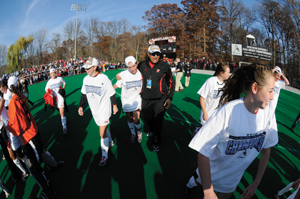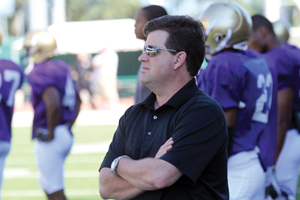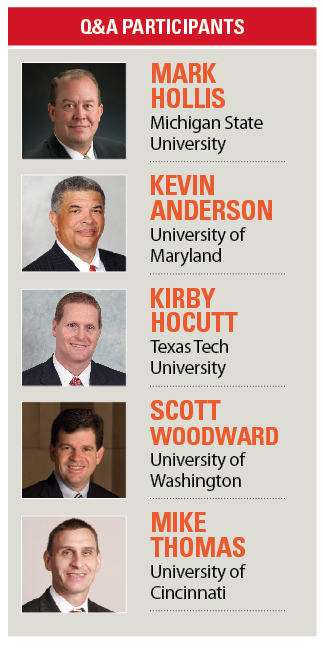SportsBusiness Journal college writer Michael Smith asked five athletic directors about the pressures on their budgets, the never-ending search for additional revenue, and how they’re trying to maintain their schools’ competitiveness and not harm the student-athlete experience. Here are highlights of their responses, which were supplied via email.
■ What new revenue stream are you working the hardest to develop or what existing revenue stream are you working the hardest to grow? Where is the most potential?
Mark Hollis, Michigan State: The DIA (Department of Intercollegiate Athletics) does not receive any state of Michigan tax dollars, university general fund dollars, student fees, tuition waivers or other forms of revenues from university/state support in its operating budget. As such, our focus has been on both enhancing revenues and managing expenses. The biggest impact continues to be focusing and maximizing the core revenue sources of ticket sales, contributions, broadcast, postseason and multimedia marketing. … Our primary focus is broadening the breadth and height of charitable giving to Spartan athletics.
 |
UNIVERSITY OF MARYLAND
Maryland’s Kevin Anderson said the school is exploring new sponsorship categories. |
Kevin Anderson, Maryland: We are currently exploring a number of new corporate sponsorship categories in an effort to grow our revenues to better support our student athletes. We are also working very hard as a staff to increase our current football ticket sales as well as our Terrapin Club fundraising efforts.
Kirby Hocutt, Texas Tech: Fundraising, marketing, sponsorships and ticket sales are areas where we have potential to create and grow revenue. Our development team does a wonderful job engaging our alumni and fans. They know our people and work to communicate the opportunities to support our student athletes. There are always more people to meet and educate about our needs — scholarships, facilities and special projects. To supplement our ticket operations, we started an outbound sales team. We have a call center with a CRM system, and this team concentrates on customer acquisition. Both units focus on delivering superior customer care and we’ve successfully generated new revenue from their efforts.
Scott Woodward, Washington: The answer to both questions is one and the same: football home games. The University of Washington has a 70,000-plus-seat stadium and we are aggressively working to maximize the revenue that can be realized in that facility from both our patrons and our advertisers.
Mike Thomas, Cincinnati: Over the past few years we have leveraged success in football to maximize a value proposition built on seating and parking. Given the limitations of our competitive venues, we must develop opportunities to capture investment from Bearcat fans to whom the priority seating and parking fails to draw in. We have developed an affinity subscription program called Bearcat Fan Advantage, which is an online platform that affords members special benefits and exclusive content. The premise behind the Bearcat Fan Advantage program is creating a platform that takes those with an interest, albeit passive, and engages them in a way that can be monetized and developed. It is a tremendous activation tool to funnel leads generated through other marketing initiatives as well as a way to build value for members of our sport-specific club.
■ What is the single most difficult budget decision you’ve made as you prepare your fiscal 2012 budget?
Hollis: Applying across-the-board reductions in administrative operations (13 percent) and sports operations (10 percent) over the past two fiscal years has been the most difficult budget decision. Increased expenses associated with financial aid, travel (fuel) and other non-negotiable expenses require us to do more with less. We have asked our coaches to be more efficient with their reduced budgets while striving to not reduce the experience for the student athlete. … We need to prioritize expenses with regard to recruiting, competitive advantage, and value to the student athlete including the increasing specialization of duties and facilities, number of staff members, facility projects, salaries and sport sponsorships.
Anderson: Our programs and coaches have all stepped up to help us to reduce expenses and find efficiencies across the board. It is my hope that we will not need to make any one single difficult budget decision but rather many strategic decisions that will allow us to be successful in our efforts to teach, to develop and to inspire our student athletes in everything we do.
Hocutt: We have adopted a zero-based budgeting strategy. Our coaches and unit directors start with a clean spreadsheet and build their budgets line by line. They’re asked to be thoughtful about the resources needed to accomplish their objectives and to be considerate of the overall department situation. We work hard to push every dollar to the direct benefit of the student-athlete experience. The toughest decisions are almost always related to staff compensation. We have committed team members and it is difficult to fully recognize everyone for their contributions.
Woodward: A tremendous challenge for us, in light of the news of the blockbuster Pac-12 media deal, is to impress
 |
UNIVERSITY OF WASHINGTON
Washington’s Scott Woodward wants to drive more revenue from football. |
upon our staff, fans and donors that it is essential that we remain focused on running a prudent and fiscally sound department. The increased income from the media rights deal will allow us to continue to provide our student athletes with a first-class academic and athletic experience and comes at a critical time in light of the skyrocketing costs of tuition.
Thomas: The most difficult budget-related decisions are based on how we attempt to do more for our student athletes when the expectations for a quality experience are outpaced by an increasing cost of doing business. Not able to be “all things for all people” results in decisions being made that may have a positive impact for one program at the detriment of another. However, in an extremely competitive industry, one has to be strategic in how to allocate dollars with the best opportunity for an increased return on investment.
■ With all of the discussion about whether schools should be paying student athletes, what is the most innovative idea you’ve heard that could work, or do you believe that student athletes should not be paid at all?
Anderson: Of all the discussion that I have seen on the subject, I think that the Big Ten Conference might be on the right track. I think that the suggestion is certainly worthy of further discussion and exploration. I believe that student athletes are paid currently and that the value of their college education is commensurate with their participation in their respective sports. With that said, I am not opposed to exploring further increasing the amount of the athletic scholarship to include the “full cost of attendance.”
Hocutt: We must never lose focus that our core mission is education. We provide extraordinary access and opportunities to earn a college degree, which is a life-changing experience. Scholarships are one of our largest costs and these expenses continue to trend upward. At the same time, we must always explore and discuss opportunities to enhance the welfare of our student athletes. While there are a multitude of things to consider and obstacles related to providing support up to the determined cost of attendance, there may be merit in revisiting the past model of providing a pre-determined amount, once referred to as “laundry money” to scholarship student athletes to assist with daily living expenses.
Woodward: I believe that it is important for our department to cover the true cost of attending this university for our student athletes and I continue to work to maximize our reimbursements of their expenses. However, I am not convinced that a straight out “pay for play” system is the right thing to do.
Thomas: I’m not of the belief that student athletes should be paid. The opportunity to receive a college education and the other benefits received should be compensation enough. In paying student athletes, how do we develop a model that makes sense for all and does not widen the gap between the haves and have nots? … Moving further from a model of amateurism speaks to a closer review of what was once a more traditional model when being a student athlete was not viewed as a 12-month job.
■ With scandal dominating so many of the headlines in college athletics, what should the AD’s role be in keeping a department free of NCAA violations?
Hollis: The keys are communication, accountability and trust. It is impossible to be with every student athlete, donor, staff member or others associated with the DIA 24/7. It is possible, however, to instill a culture of “eyes wide open” and “communication for the common good” in the pursuit of excellence in the classroom and in the competitive arena. There should be no surprises placed on anyone that is involved in the process of our student athletes. Education, open dialogue, asking questions and bringing to light issues that may be a concern are critical in our fast-moving world.
Anderson: I believe that you must inspect what you expect. This must be done regularly in order to have a pulse on what is going on in the department and also to share my vision and expectations with the staff.
Hocutt: It is setting the expectations from the top. You demand integrity and a culture of compliance. It is everyone’s responsibility to play within the rules governing fair play. Intercollegiate athletics creates so many positives — access to education, development of life skills, deep connections to your alma mater, community enhancement. These are invaluable. Not adhering to the rules mutes these positives.
Woodward: As AD, it is my job to remain vigilant about improper activities — educate, educate, educate. Teach the staff, coaches and student athletes about potential pitfalls and maintain a culture that doesn’t accept the types of shortcuts that can lead to scandal. Moreover, I remain watchful with the understanding that staying on solid ground when it comes to scandal and violations can be a very difficult task and mistakes are all too easy to make.
Thomas: It is imperative a culture and atmosphere is established reflecting the absolute importance of rules compliance at all levels of the organization. The importance of compliance must be universal and shared by all including the full cooperation of the student athletes. The foundation of a strong compliance program is an ongoing education program and comprehensive monitoring at all levels, though it is unrealistic to be with people in the program 24/7/365. The goal is to be proactive, diligent and transparent, and act swiftly and decisively when issues arise.
■ What is the trend in college sports business that you’ll be watching in the coming months?
Hollis: Social media and the immediacy of information, both factual and rumored, have changed the way we look at the world. The benefits and liabilities continue to be weighed against each other. There is no doubt, however, that it has changed the way presidents, administrators, coaches, student athletes, fans, media and many others are intertwined in college sports. The commercialization of college athletics is yet another area that we will continue to watch. This includes the impact that third-party organizations have in influencing college sports in roles as youth sports coordinators, corporate engagement and agents.
Anderson: I’ll be paying close attention to the work of the NCAA Bowl Licensing Task Force in the coming months as they review the current football bowl structure and ensure the integrity of the system.
Hocutt: The digital technology growth and integration into the fan experience is exciting and expanding. The access to streaming content and information on PDAs, smartphones, tablets and other handheld devices is a rapidly developing area, and one that can provide increased exposure while even enhancing the spectator’s enjoyment of a live game.
Woodward: In the market of live sport entertainment, there are a lot of options for the consumer and fan. As a result, we have to offer a product at our venues that is compelling and generates a level of interest that beats out our biggest competitors: the HDTV and the leather couch.
Thomas: Social media has emerged as a primary form of communication which requires we are educated and proactive regarding how to deal with the ever-changing media. ... Though social networking provides tremendous opportunities to market and inform our various constituents, it can also be viewed as a liability if unfiltered in this instant response age. Thus, it will be critical to have the resources in places not only to enhance the benefits of social media, but more importantly to minimize potential liabilities in a proactive manner.






